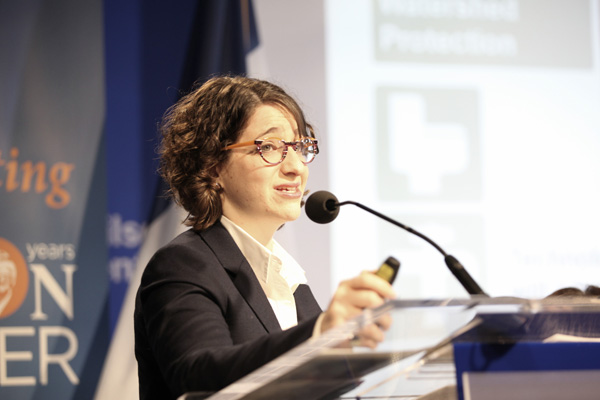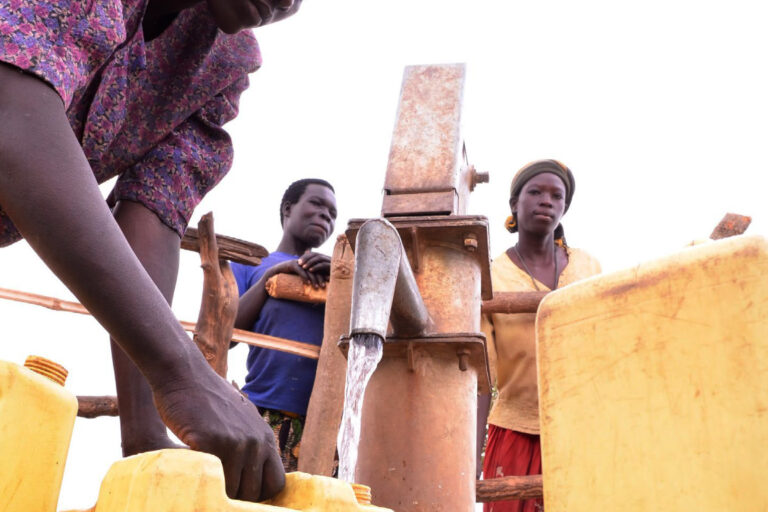
“Hope is Not a Strategy”
SWP’s panel of experts discusses solutions to the challenge of erratic water.
“Water variability has always existed,” said USAID Climate Change Adaptation Specialist Jonathan Cook, opening the fourth and final “Sustainable Water, Resilient Communities” event. For centuries, places and people around the world have depended primarily on erratic water supplies; in Cambodia, for example, people have adapted over time to the fluctuation brought on by the annual monsoon. “Yet variability is increasing in many places due to climate change and due to more frequent natural disasters,” Cook added. Communities can’t always cope with the heightened unpredictability, especially when it’s exacerbated by poor water management, outdated infrastructure, and political and social conflict.
At the event, co-hosted by the USAID-funded Sustainable Water Partnership (SWP) and the Wilson Center, panelists came together to discuss challenges of water variability – challenges which are, at first glance, staggering. Today, 1.5 billion people live in countries that are water scarce, a figure that’s projected to double over the next two decades. According to the World Economic Forum’s 2018 Global Risks Report, water crisis is one of the five risks that will have the biggest social impact over the next 10 years.

Water Foundry CEO Will Sarni discusses the importance of the language we use around water problems. Photo courtesy of the Wilson Center.
“Business as usual is not acceptable anymore,” said Water Foundry CEO Will Sarni. “Hope is not a strategy.”
The status quo is especially risky when it comes to the nexus of water and agriculture. “Agriculture currently uses about 70 percent of the world’s freshwater resources… but only about 20 percent of the cropland across the whole world is actually using irrigation,” said Dr. Kate Tully, assistant professor of agroecology at the University of Maryland. Most of the world’s croplands and farmers rely on rainfall.

Dr. Kate Tully of the University of Maryland explains how food waste contributes to water crisis. Photo courtesy of the Wilson Center.
While some foods take much more water to produce than others — beef, for example — the globalization of trade means that the regions consuming food aren’t always the same regions feeling the environmental effects of the water used to produce it. “We now are relying very heavily on a few water-rich regions to provide most of our food,” said Tully.
But as water variability increases, food and agriculture will face major impacts. Eight major crops across Africa and South Asia will see declines in yields, affecting the food supply of the whole world. “This means we need to really think about where we farm, what we eat and the kinds of diets we might be eating in the future,” said Tully.

Dr. Kathleen White of USACE explains how problems like drought affect the Corps’ work. Photo courtesy of the Wilson Center.
Erratic water conditions also affect water infrastructure here in the U.S., threatening transportation and trade. Droughts, especially, present a real problem for the United States Army Corps of Engineers, according to Dr. Kathleen White, lead of the Corps’ Climate Preparedness and Resilience Community of Practice. The Corps manages the country’s water infrastructure, like channels and dams, which recover faster from flood than from drought. “If you can’t get any barges down the river, then there’s a real problem,” White said.

Scott Houston of California’s West Basin Municipal Water District explains how diversifying water sources can offset problems related to water variability. Photo courtesy of the Wilson Center.
So what, realistically, can we do to combat these challenges? The solutions range from complex – water recycling – to simply changing the way we talk about water issues.
Scott Houston, a board member for California’s West Basin Municipal Water District, explained just a few ways the state is combatting the problems of erratic water. For example, El Segundo’s Edward C. Little Water Recycling Facility, the only plant of its kind in the world, is producing more than 185 billion gallons of recycled water per year, both for industrial and agricultural purposes. This reduces dependence on imported water and diversifies California’s water supply.
Combatting variability on a small-scale in the developing world presents different challenges. “If you want to bring a technology into the developing world, there has to be local capacity building,” said Tully. All the solar-powered irrigation systems in the world will do no good if locals don’t have the training or financial stability to maintain them. Sometimes the solution isn’t introducing new technology at all, but rather working with what’s already available. “There are all kinds of different methods for obtaining water that we could potentially improve on but not radically alter,” White added. “The idea is to work with the tradition of the people that you’re working with. That way it will be more likely to be maintained over time.”
Changing the status quo can be as simple as changing the way we talk. “Language really does matter when you’re trying to engage stakeholders on changing how they treat a product that is almost free, and in their view, abundant,” Sarni said. Calling prolonged water scarcity a “drought” can lead people and companies to believe the situation is both temporary and beyond their control.
“The panelists underscored the growing uncertainty of water availability and quality around the world, and the fact that we can no longer manage and use water the way we have in the past,” said SWP Deputy Director John Parker in response to the event. “Solutions exist, but bringing them to life effectively takes significant effort.” That’s why in countries around the world facing growing unpredictability in their water supply, SWP is responding to the challenges at hand. “We’re actively working with stakeholders to more effectively plan, design and implement measures that account for an uncertain future and build long term resilience,” Parker said.
“We have a choice here,” Sarni said at the event. “We can create abundance without waste by really thinking creatively, or we can be stuck in our business as usual, wringing our hands, and think about what can’t be done.”
SWP is choosing to think creatively, to create abundance.
This post also appears on the Sustainable Water Partnership website.
Feature photo courtesy of the Wilson Center.
Related Projects

